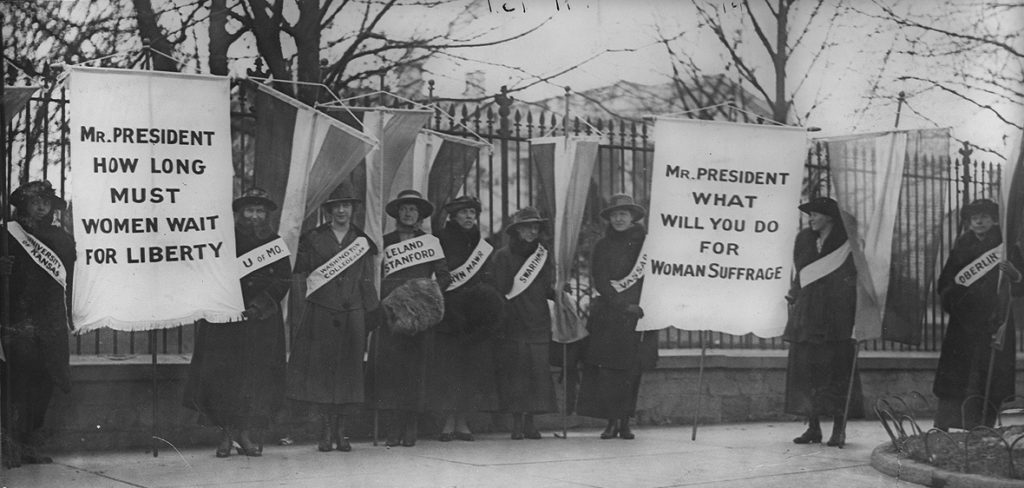This year marks the centennial of the ratification of the 19th Amendment to the Constitution. A hundred years after suffragists fought for and won the right to vote, women voters—empowered by the feminist, civil rights and LGBTQ movements—will likely determine the outcome of the high-stakes elections of 2020.

Indeed, the power of women voters and feminist candidates to secure women’s rights is right now on display in Virginia, where the State House and Senate have just voted to ratify the Equal Rights Amendment, making theirs the 38th and final state needed to add women to the Constitution.
For more than two decades, the Virginia House’s right-wing leadership has stopped the ERA from coming to the floor for a full vote. But in the 2017 state legislative election, and again in the 2019 election after a court-mandated redistricting to fix racial gerrymandering, feminist candidates along with women’s votes flipped long-held Republican seats. The result: a Democratic, pro-women’s equality majority in both houses of the Virginia General Assembly for the first time ever. The new speaker, the first woman to hold the position in the 400-year history of the Virginia House, will be feminist Eileen Filler-Corn, and the majority leader will be feminist Charniele Herring, the first African American to be elected chair of the Democratic Party of Virginia.
First put forth in 1923 by suffragist leader Alice Paul, the ERA was finally approved by Congress in 1972 and sent to the states for ratification. Long a priority of the contemporary feminist movement, the ERA now garners nearly universal—more than 90 percent—support among both women and men in the U.S. The drive for ratification was forestalled in 1982, but gained new momentum in 2017 after feminists helped flip both houses of the Nevada legislature from red to blue. Led by state Sen. Pat Spearman, an African American veteran (lieutenant colonel in the Army) and the first openly lesbian member of the Nevada legislature, Nevada voted to become the 36th state to ratify. In 2018, the Illinois Senate and House followed suit, making their state No. 37.
“No question the ERA is finally in the homestretch,” says Eleanor Smeal, president of the Feminist Majority and publisher of Ms.; she’s been a leader in the ERA ratification effort for nearly five decades. The battle appears likely to shift next to the courts.
In December, the Republican attorneys general of Louisiana, Alabama and South Dakota filed a lawsuit to stop more states from ratifying, based on the arbitrary time line Congress placed in the preamble to the ERA and on attempts by five states to rescind their ratification vote. “The time line was not voted on by the ratifying states and is therefore non-binding. In fact, the Congress has already changed the time line in the preamble once before,” Smeal explains. “What’s more, no state rescission of a constitutional amendment has ever been recognized.” Referencing the overwhelming support among both women and men in the U.S. for the ERA, she adds, “Women will not be denied our full rights under the law.”

This piece is excerpted from the Winter 2020 issue of Ms.
Become a Ms. member to read the rest—and get even more of our feminist reporting and analysis delivered to your door, or to your mobile device, each time we release a new issue!
Political candidates who oppose women’s full equality should be wary: Women’s votes are set to shape the outcome of the 2020 national elections and set the course for the nation’s agenda. The gender gap, first identified by Smeal and other ERA activists, emerged in the presidential election of 1980, in which noticeably fewer women than men voted for Ronald Reagan. Although not decisive in that race, by 1982 the gender gap and women’s votes had determined the outcomes of gubernatorial elections in New York, Texas and Michigan, where pro-women’s rights Democrats emerged victorious. And by 1984, the gender gap was the driving force in the election of Democratic senators in Iowa and Illinois and was decisive in the victories of Democratic senators in Massachusetts and Michigan.
The gender gap is now a firmly established factor in U.S. elections, driving the outcome of races from local city councils and county boards to Congress and the presidency. In the 2018 midterm elections, women candidates and women’s votes shifted the balance of power in the U.S. House, and the gender gap was again decisive in the 2019 Kentucky governor’s race, with 56.7 percent of women—but only 44.4 percent of men—voting for the winning pro-women’s rights Democratic candidate.
Early polling suggests the 2020 elections could see record gender gaps. In an Economist/YouGov poll from October, 52 percent of women said they will vote for the Democratic Party’s congressional candidate (only 36 percent said they will vote for the Republican), compared to 43 percent of men who said they will vote Democrat (and 44 percent Republican). In the same poll, 50 percent of women disapprove of President Donald Trump’s handling of women’s rights issues, with 40 percent strongly disapproving; only 39 percent of men disapprove. Across all major polls, women—especially women of color, and including politically unaffiliated and independent women—have been more critical of Trump’s actions and more supportive of his impeachment than men. In the most recent Fox News poll available at press time, 54 percent of all women and 69 percent of women of color said they think Trump should be impeached and removed from office, compared to 44 percent of all men.
To explore what all this might mean, and to better understand the factors driving these large gender gaps, Ms. spoke with Ethel Klein, Ph.D.—leading pollster, gender gap expert and author of the 1984 book Gender Politics: From Consciousness to Mass Politics. Become a member of Ms. to get our latest issue and read the interview!





